Short answer: If you juggle work + personal inboxes, pick an app with unified inbox, per-account rules, send-delay/undo-send, and reliable search. We compare the best options for iOS and macOS below.
Email overload is a modern epidemic—especially in the US, where professionals juggle multiple email accounts across work, personal, and side projects.
According to Zerobounce's 2025 Email Statistics Report, 88% of users check their inbox daily, with some checking more than 20 times a day—a habit that can disrupt focus and contribute to digital fatigue.
Furthermore, 86% of people now use at least three email addresses—often spread across different platforms, such as the Gmail app, webmail, or desktop clients.
If you're constantly switching between email apps to stay on top of your different accounts, you're likely wasting time, missing messages, or battling chaos.
But here's the good news: you don't need a different email client for each account.
In this guide, we've tested and compared the best email apps for managing multiple accounts, including free email apps. Whether you need privacy, AI assistance, or even a smart Gmail alternative, this guide will help you find the right tool to take control of your inbox.
[cta-block:ctablock3,title="Unify work + personal email",subtitle="Faster triage with a true multi-account client",button1="Try it Free",button1link="https://canarymail.io/downloads",button2="Learn More",button2link="https://canarymail.io/"]
Best Email Apps Multiple Accounts [Comparison Table]
Here’s a quick comparison of the top email apps for managing multiple accounts in 2025:
Want the only app that nails all these boxes? Download Canary Mail
Why It’s Important to Have Multiple Email Accounts
Keeping separate personal and work inboxes helps prevent overlap, miscommunication, and overwhelm.
Using multiple email accounts helps:
- Reduce distractions and improve email productivity
- Protect sensitive data by keeping work and personal email separate
- Stay organized when juggling different roles or responsibilities
But these benefits only matter if you can easily manage them. Let’s explore the challenges that make this harder than it should be.
Top Challenges in Managing Multiple Email Accounts
Managing multiple email accounts across platforms can quickly become overwhelming, especially without the right tools.
Here are 5 key obstacles that stand in the way of efficient email management:
1. Inbox Overload
If you have several inboxes open across different tabs, it's easy to lose track of what matters. Email management becomes chaotic, especially if your email client lacks smart organization features.
2. Security Gaps
Using one password across accounts or relying on webmail with weak security features exposes you to data breaches and phishing.
3. Cross-Platform Limitations
Not every email app works seamlessly across operating systems. Something that works on Mac might be missing from Android, or vice versa.
4. Productivity Losses from Account Switching
Jumping between accounts all day kills your focus. Without a unified inbox, context switching leads to fatigue.
5. Storage & Bloat
Email apps like Gmail store everything forever. Without smart filters, your email communication turns into digital clutter.
Now let’s break down what to look for in a tool built for this reality.
How to Choose the Best Email Client for Multiple Accounts
Effectively managing multiple inboxes means finding an email client that combines usability, security, and smart organization. Whether you're handling personal and work emails or juggling multiple email addresses, here are the essential features to consider:
Essential Features for Multiple Account Management
The right tool should reduce friction, improve focus, and protect your data, without overcomplicating your workflow.
- Unified inbox: View emails from all your separate inboxes in one streamlined interface.
- Account switching: Easily toggle between sender addresses or inboxes
- Notification management: Customize alerts per personal account to reduce distractions and prioritize what matters most.
- Global search: Find emails, attachments, or keywords across all inboxes instantly
- Security features: Look out for features like end-to-end encryption, Pretty Good Privacy (PGP) support, and two-factor authentication (2FA)
- Data compliance: Ensure support for GDPR (General Data Protection Regulation), CCPA (California Consumer Privacy Act), and in-region data storage
Platform Compatibility Considerations
Your email app should work everywhere you do—on any device, anytime. Whether you're juggling accounts on a phone during your commute or responding to client emails at your desk, seamless access is non-negotiable.
- Cross-platform compatibility: Managing inboxes across devices requires an email client that works seamlessly on Windows, macOS, iOS, and Android. Look for tools that support multiple email providers—Gmail, Outlook accounts, Yahoo Mail—and deliver a consistent experience on every platform. If you're switching from something like Windows Mail or the default standard email app, these modern tools offer significantly better performance and flexibility.
- Mobile and desktop sync: Ensure real-time syncing of inboxes, contacts, and preferences so you’re always up to date.
- Web access or extensions: Bonus points for apps with browser access or web-based versions that keep you connected without a dedicated install.
- Third-party integrations: Beyond platform access, the best apps connect with third-party apps like CRMs, calendars, and file storage—turning your inbox into a productivity hub.
Cost vs. Features
Not all apps are priced equally—and not every feature is worth paying for.
- Free vs. premium: Look for a trial or free tier to test core functionality
- Payment models: Monthly subscriptions vs. one-time purchases
- Use case fit: Match features to needs—solo user, freelancer, or support team
Now that you know what you're looking for, let’s compare the top apps.
11+ Best Email Apps for Managing Multiple Accounts
With so many apps claiming to streamline email management, it’s important to separate the gimmicks from tools that truly improve productivity.
Below are the top performers in 2025—each tested for how well they handle multiple inboxes, security, speed, and user experience.
1. Canary Mail: The Best Email App for Managing Multiple Accounts (macOS & iOS)
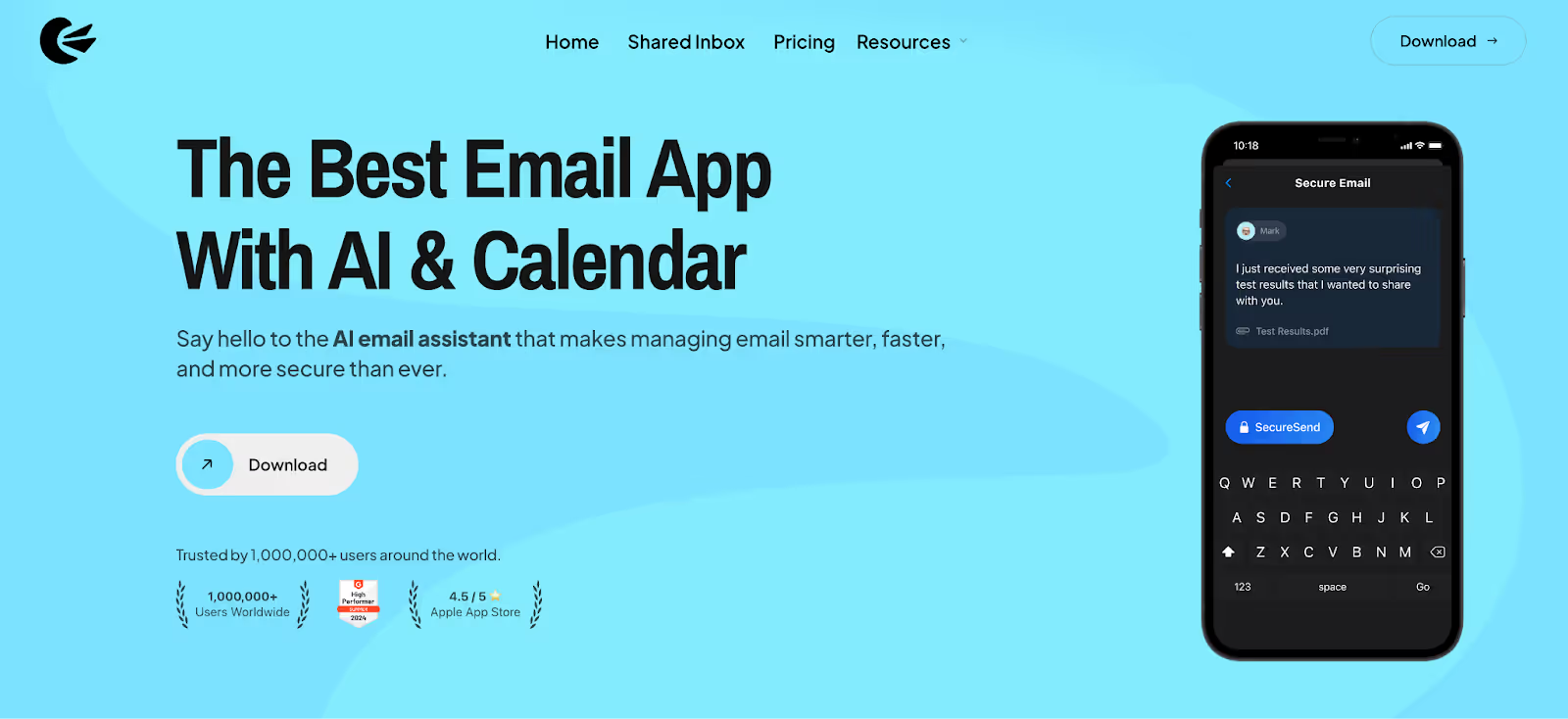
If you’re looking for a sleek, secure email client that makes managing multiple emails simple and intuitive, Canary Mail stands out from the pack. It combines end-to-end encryption, intelligent automation, and a refined design, without the bloat of traditional options.
Unlike the standard mail app that comes pre-installed on many devices, Canary is built from the ground up for professionals who value performance and control. Compared to Microsoft Outlook, Canary delivers stronger privacy controls, smarter workflows, and a faster, cleaner user interface.
It’s a compelling Gmail alternative for users tired of clutter and outdated UI. For Apple users seeking more than what Apple Mail offers, Canary delivers powerful AI triage, cross-platform syncing, and unified search that work the way you do.
Key Features:
- Unified inbox: Consolidate all your email accounts into one clean, organized view
- End-to-end encryption: Built-in security with PGP (Pretty Good Privacy) support for confidential communication
- Cross-platform: With full support for mobile devices, Canary ensures seamless access on the go.
- Same app experience: Canary brings your inboxes and productivity tools together in the same app, eliminating the need for fragmented workflows across multiple tools.
- Smart filters and Focus Inbox: Surfaces priority emails and hides clutter
- Customizable notifications: Set per-account alerts, quiet hours, and contact-based filters
- Copilot AI: Introducing the future of email: compose, summarize, and reply with AI-powered precision and speed
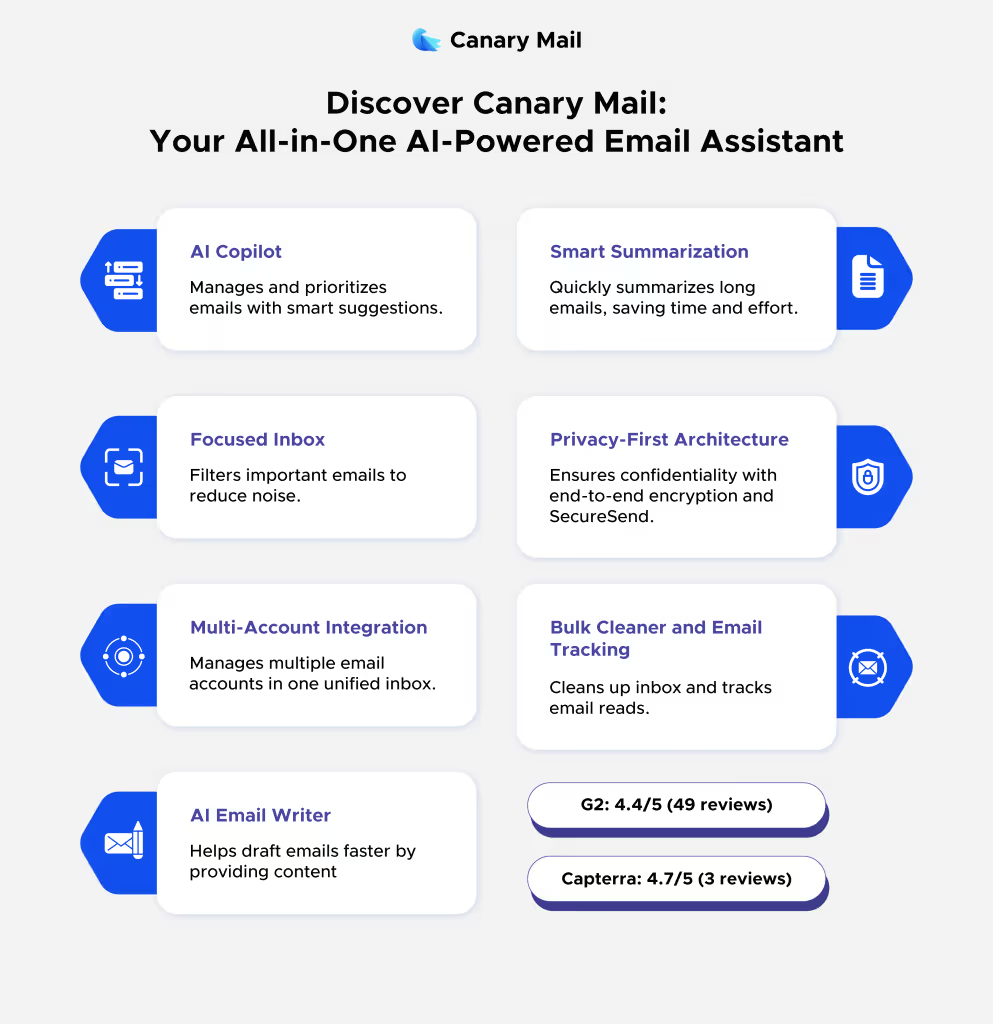
- Pros:
- All-in-one productivity and privacy platform
- Fast, minimal interface that works consistently across devices
- AI Copilot boosts response speed and inbox clarity
- Cons:
- No browser-based version yet
- Some features require upgrading to a paid plan
- Pricing: Free plan available; Premium plan starts at $3/month
- Platform availability: iOS, Android, macOS, Windows
- Best for: Professionals seeking a secure, fast, and intelligent Gmail alternative
Why Canary Mail is the Top Choice for Apple Users
If you’re on macOS or iOS, Canary Mail is built with Apple users in mind. While many email apps try to support every platform, Canary focuses on delivering the smoothest, most secure experience on Mac and iPhone.
Here’s why it stands out for Apple users:
- Unified inbox for multiple accounts – Manage Gmail, Outlook, iCloud, Yahoo, Proton, and more in one clean interface without lag.
- Native macOS and iOS design – Canary feels like a natural extension of Apple’s ecosystem, with seamless performance across Mac and iPhone.
- Privacy-first by default – End-to-end encryption (PGP & SecureSend) and zero data mining keep your messages safe.
- AI-powered email assistant – Organize your inbox, draft faster replies, and stay focused without manual sorting.
- Reliable read receipts – Know when your emails are opened, without relying on limited or intrusive third-party tools.
- Offline mode – Work on your emails even without internet and sync instantly once you’re back online.
👉 Ready to simplify your inbox? Download Canary Mail for Mac and iPhone and enjoy a faster, smarter, and more secure email experience across all your accounts.
[cta-block:ctablock2,title="Too many inboxes?",button1="Download Now",button1link="https://canarymail.io/downloads",button2="Compare Options",button2link="https://canarymail.io/blog/apple-mail-alternatives"]
2. Outlook: Best for Microsoft Users

If you’re already embedded in the Microsoft ecosystem, Outlook is the logical choice. With deep integration into Microsoft 365, powerful multi-account support, and enterprise-grade security, it's a top pick for business users.
Microsoft Outlook supports multiple providers—including your Outlook account, Gmail, Yahoo Mail, and custom IMAP setups—so you can manage everything from one inbox. It also lets you manage multiple Gmail accounts alongside your Outlook inbox, making it a flexible hub for cross-platform users.
For those using Google tools, Outlook integrates seamlessly with Google Workspace, giving you access to Gmail, Google Calendar, and Drive files—all in one place.
- Key Features:
- Unified inbox: Combines all inboxes into a single view
- Multi-platform access: Runs on web, mobile, and desktop
- Microsoft 365 integration: Syncs with Teams, OneDrive, and Calendar
- Organizational tools: Focused Inbox, Categories, and Rules to filter messages
- Pros:
- Familiar interface for Microsoft users
- Enterprise-grade security and support
- Bundled with many Microsoft 365 subscriptions
- Cons:
- Can feel bloated or complex for casual users
- Limited customization options
- Pricing: Free plan available; Microsoft 365 plans start at $9.99/month
- Platform: iOS, Android, macOS, Windows, Web
- User Experience and Productivity Benefits: Outlook blends email, calendar, and file management into one cohesive ecosystem. Its Focused Inbox filters low-priority emails while tight integration with Teams, OneDrive, and Office apps means you can manage communication and collaboration in the same place.
- What Makes It Unique: Unlike standalone email apps, Outlook functions as a full-fledged digital workspace. It serves as the hub for Microsoft 365, giving users seamless access to email, scheduling, cloud storage, and collaboration under a trusted, enterprise-ready model.
- Best for: Business users and anyone tied into Microsoft 365 services
3. Missive: Best for Teams
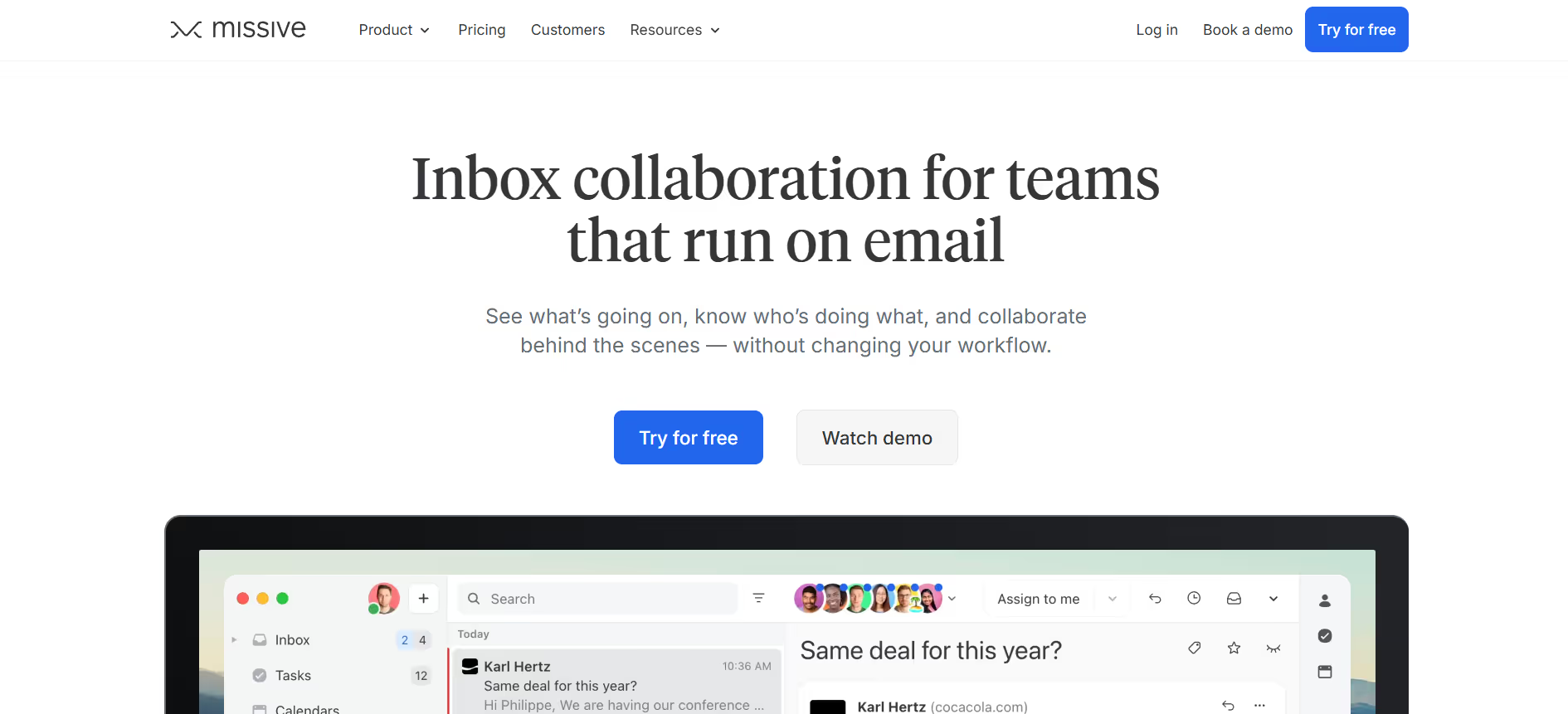
Ever wish Outlook and Teams would work nicely together? Or Gmail and Slack? Missive is a collaborative inbox that allows you to internally collaborate on emails, making it easy to stay organized and on top of who's doing what.
- Key Features:
- Multiple organizations and accounts: Supports all email providers and you can add all your organizations and accounts
- Internal collaboration: Assign, mention teammates, draft messages together
- Flexible rules and automations: SLA breaches, auto-assignment, auto-drafting, and anything you can dream up
- Pros:
- Looks and feels like a regular email client
- High level of security (SOC 2 Type II certified)
- Rules engine and integrations with 25+ apps allows you to centralize communication
- Cons:
- Limited offline access
- Pricing: Free plan available; Starter plan starts at $14/user/month (billed annually)
- Platform: Windows, Web, iOS, Android
- User Experience and Productivity Benefits: Missive's interface feels like a regular email client, making it easy for both tech-savvy and non-tech-savvy teams to adopt. Built for all platforms and email clients, it is meant to fit into your existing system reducing the amount of change needed.
- What Makes It Unique: Missive turns your inbox from a single player game into a multiplayer game. The ability to work on emails as a team—knowing exactly who saw what, who did what, and who's doing what.
- Best for: Teams who have high-touch and/or high-volumes of emails.
4. Mailbird: Best for Windows Users
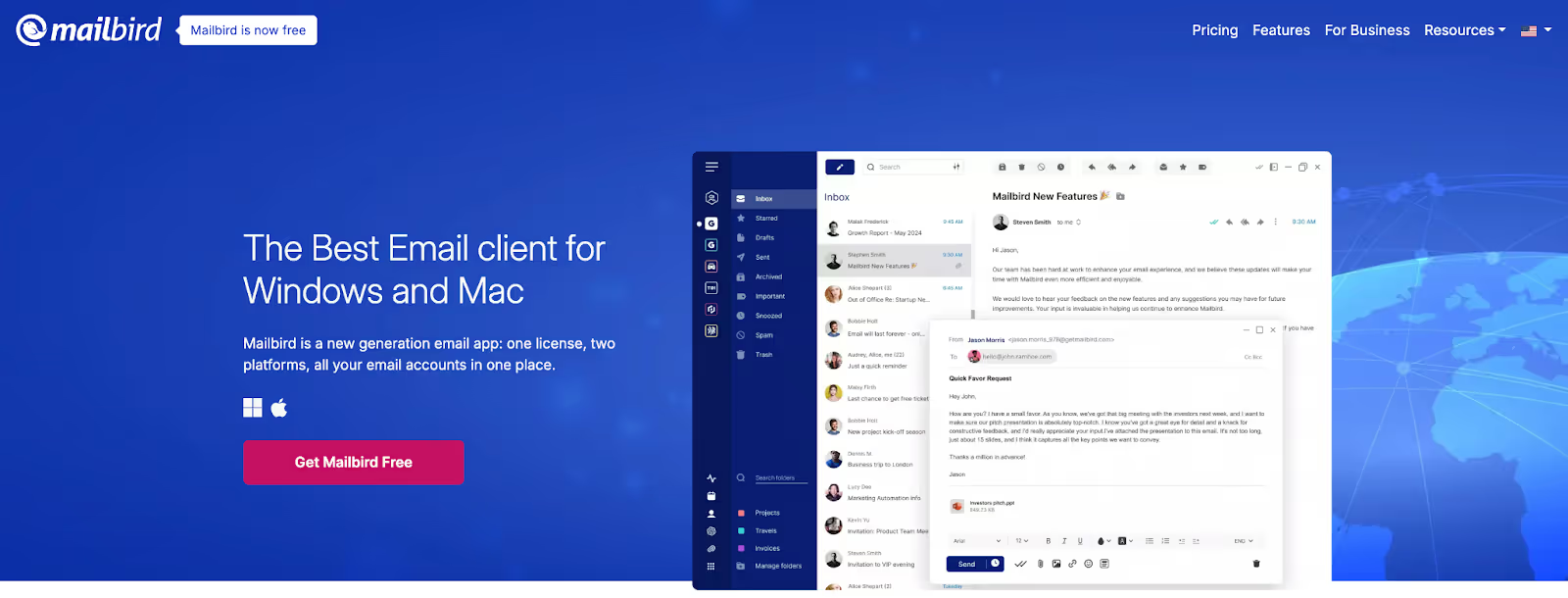
Mailbird is optimized for Windows and praised for its clean, user-friendly interface that makes switching between accounts fast and intuitive. With strong third-party integrations and a focus on simplicity, Mailbird brings all your inboxes and productivity tools under one roof.
- Key Features:
- Unified inbox: Streamlined dashboard for all your accounts
- App integrations: Mailbird connects seamlessly with Google Workspace tools like Google Calendar, helping streamline personal and professional workflows.
- Custom layouts: Adjustable pane view and color themes
- Pros:
- Optimized for Windows performance
- Deep productivity integrations
- Highly customizable interface
- Cons:
- No native mobile app
- Occasional sync lags with certain providers
- Pricing: Free plan available; Premium plan starts at $2.88/month (billed annually)
- Platforms: Windows, macOS (beta)
- User Experience & Productivity Benefits: Mailbird’s clean and customizable user interface makes managing multiple email accounts and apps feel intuitive. It syncs notifications in real time, and its integrations with tools like Google Calendar and Todoist help you stay organized without leaving your inbox.
- What Makes It Unique: Mailbird transforms your email app into a productivity command center. Unlike traditional email clients, it’s a centralized hub that brings messaging, task management, and integrations into a single workflow—saving you clicks and boosting efficiency.
- Best for: Windows power users and productivity enthusiasts
5. Spark
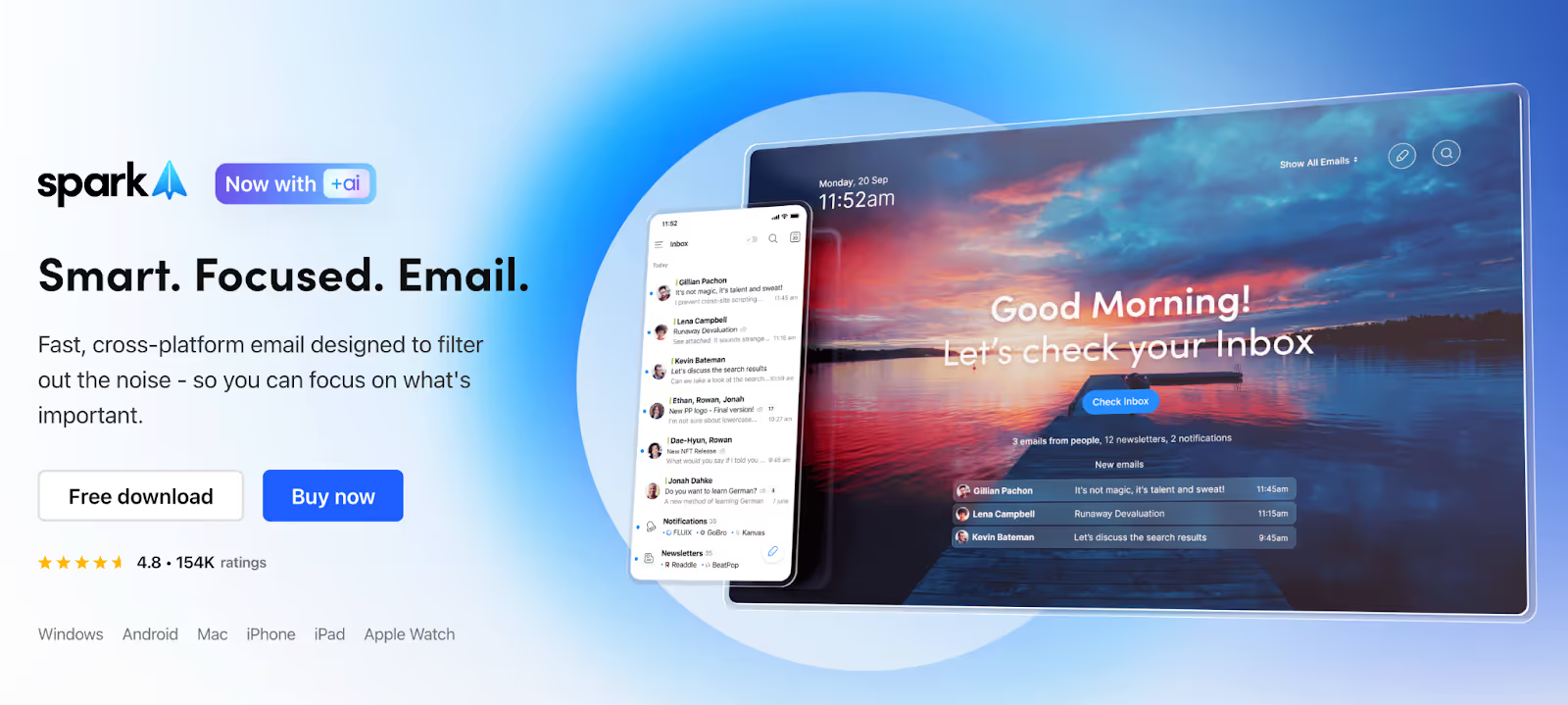
Spark is a sleek Gmail alternative for Apple users who want smarter inbox control, team collaboration, and unified search.
If you’ve outgrown Apple Mail, Spark delivers a more modern interface with intelligent organization and multi-account support.
- Key Features:
- Unified inbox: View and manage all email accounts in one place
- Team tools: Shared inbox, commenting, and collaborative drafts
- Smart features: Priority Inbox, snooze, reminders.
- Pros:
- Clean and intuitive UI
- Collaboration features for small teams
- Some AI features like Smart Reply and Smart Search
- Cons:
- No end-to-end encryption
- Limited customization options on mobile
- Pricing: Free plan available, Premium plan starts at $4.99/month (billed annually)
- Platforms: macOS, iOS, Android
- User Experience & Productivity Benefits: Spark offers a beautifully designed interface with intuitive gestures, smart inbox sorting, and seamless multi-account support. It helps users prioritize important emails and collaborate through shared drafts and comments—making it ideal for small teams and fast-moving professionals.
- What Makes It Unique: Spark reimagines email as a collaborative tool, offering real-time team commenting, shared inboxes, and unified search across all accounts and threads—turning traditional email into a more agile workflow platform.
- Best for: Apple-first users and small teams
Spark has gained popularity for its collaborative features, but some Apple users still prefer native integration — see our full comparison in Apple Mail vs Spark.
6. BlueMail: Best for Android Users
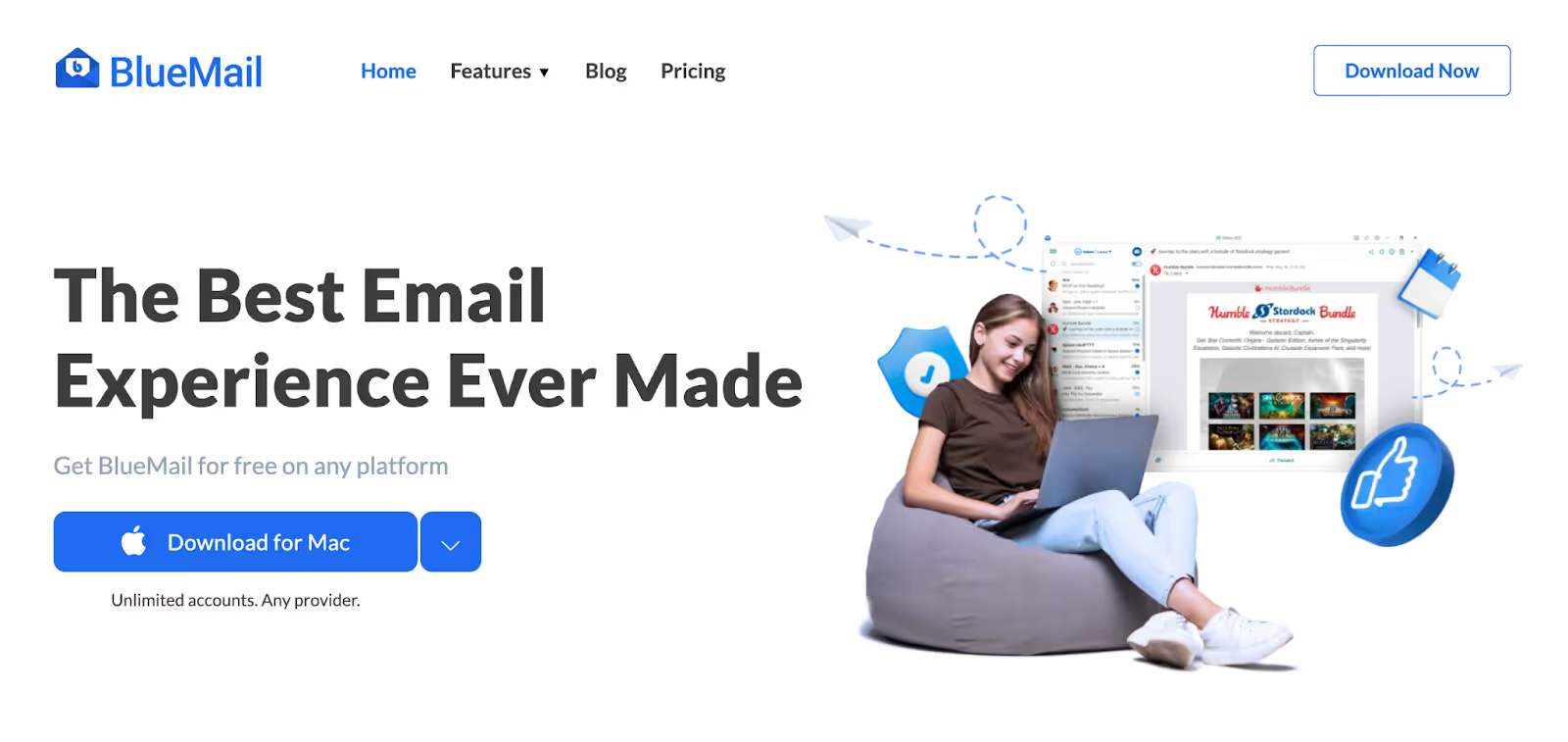
A long-time favorite on Android, BlueMail offers a balance of power and simplicity, pairing smart notifications with a clean interface. It’s an excellent choice for users seeking a feature-rich tool that’s also completely free.
Among free apps, BlueMail stands out for Android users who want a full-featured, no-cost solution for managing multiple email accounts.
- Key Features:
- Unified inbox: Consolidate multiple email accounts
- Smart notifications: Per-account customization
- Cluster feature: Groups similar emails to reduce clutter
- Pros:
- Stands out among free apps with full multi-account support
- Easy to set up and use
- Optimized for Android
- Cons:
- Lacks end-to-end encryption
- Basic desktop app lacks polish
- Pricing: Free plan available; Pro version starts at $3/month (billed annually)
- Platforms: Android, iOS, Windows
- User Experience & Productivity Benefits: BlueMail keeps things simple with a clean, responsive layout and intelligent features that organize emails by sender. It’s particularly helpful for users who want quick access to important threads without getting bogged down in clutter.
- What Makes It Unique: Unlike many free apps, BlueMail offers robust multi-account support, smart filtering and native calendar integration, without pushing users toward a paid tier. It’s the rare blend of simple, flexible, and zero cost.
- Best for: Android users who want a reliable free app
7. Rambox: Best Free Option
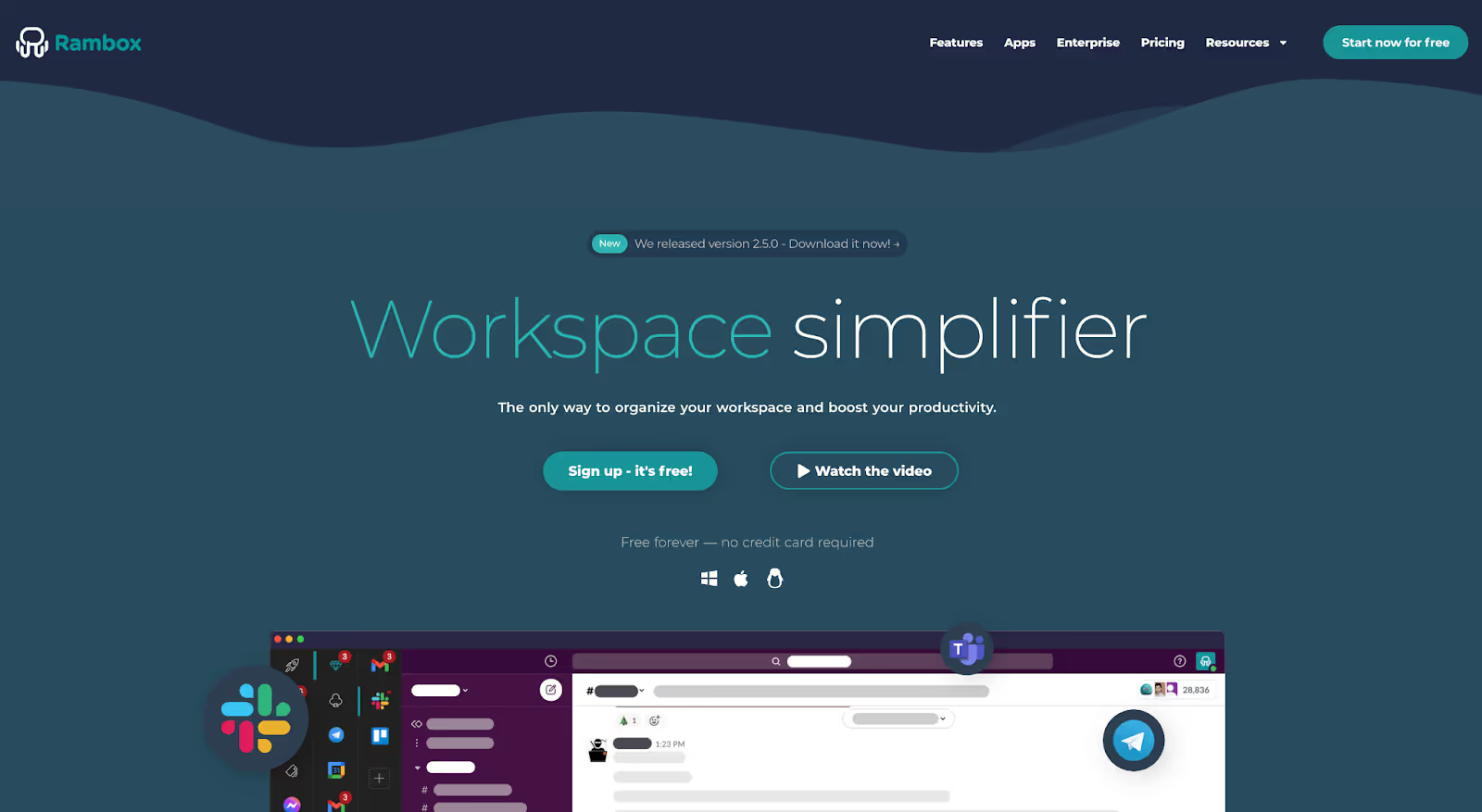
Rambox is more than just an email app—it’s a customizable productivity hub that lets you manage email alongside tools like Slack, Trello, and more. It also supports Google Workspace apps like Gmail, Calendar, and Drive directly into your dashboard for unified access.
- Key Features:
- Unified workspace: Manage email and productivity tools together
- Cross-platform: Available on all major desktop OS
- Workspace profiles: Customize app layouts per use case
- Pros:
- Highly customizable
- Combines email and other apps in one place
- Free version is powerful
- Cons:
- Cluttered interface
- Can consume a lot of memory
- Pricing: Free plan available; Pro plan starts at $5.83/month (billed annually)
- Platforms: macOS, Windows, Linux
- User Experience & Productivity Benefits: Rambox lets users centralize their communication workflows, switching seamlessly between email, chat, calendar, and productivity tools in one unified interface. It reduces tab clutter and improves focus for digital multitaskers.
- What Makes It Unique: Rambox is more than an email client—it’s a customizable workspace hub. With app profiles, password protection, and layout personalization, it stands out as a true command center for all your apps.
- Best for: Users who want an all-in-one productivity tool
8. ProtonMail: Best for Privacy
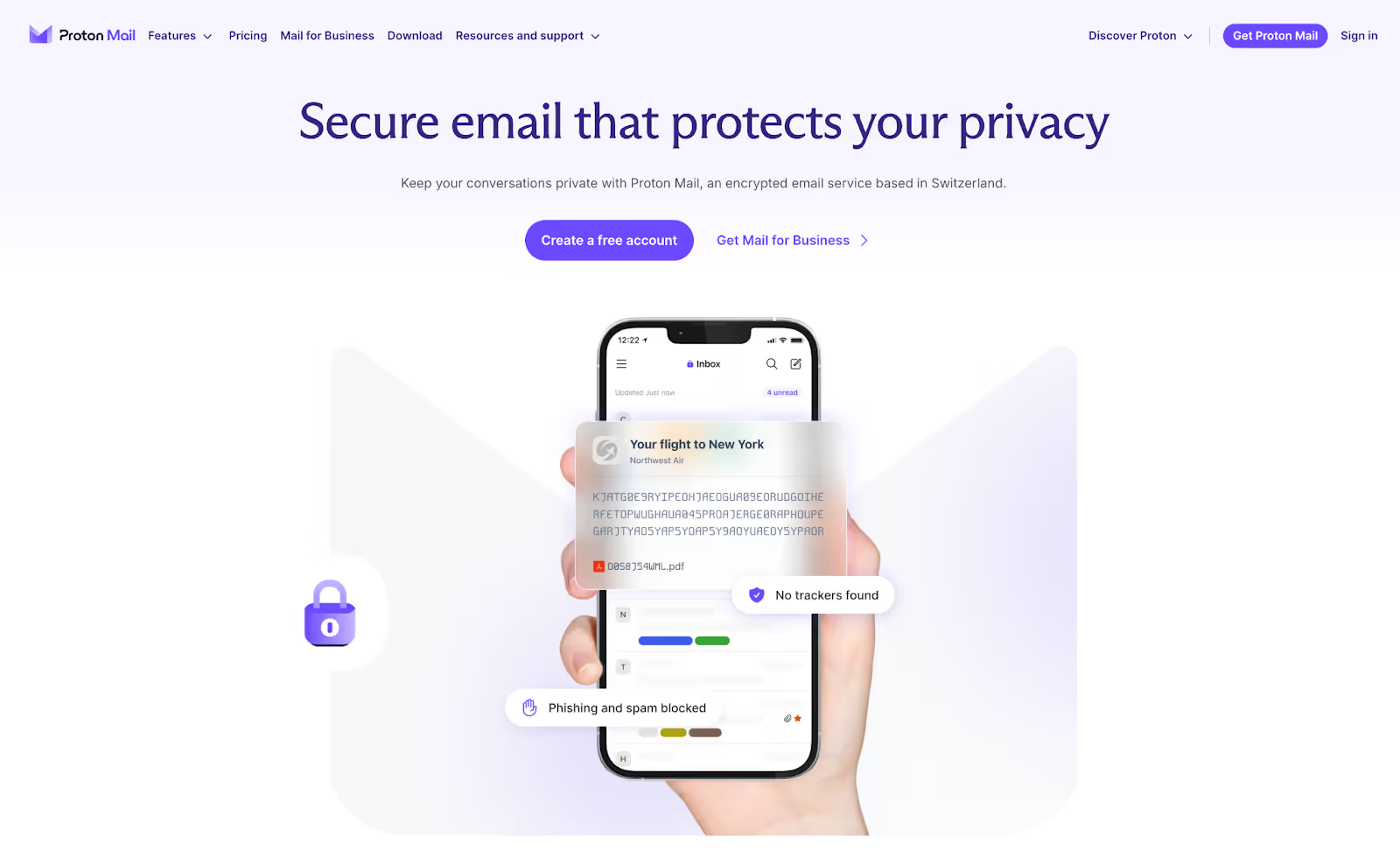
Built with security at its core, ProtonMail is a privacy-first email provider offering robust encryption and a commitment to zero data access. ProtonMail’s free version already has privacy protections few competitors can match.
- Key Features:
- End-to-end encryption: Protects messages at rest and in transit
- Anonymous sign-up: No phone number or personal info required
- Open source: Transparent and regularly audited
- Pros:
- No ads or tracking
- Excellent encryption and data protection
- Strong reputation among privacy advocates
- Free version includes robust privacy protections with no ads or tracking
- Cons:
- No unified inbox
- Limited integration and customization
- Pricing: Free plan available; Paid plan starts at €9.99/month (billed annually)
- Platforms: Web, iOS, Android
- User Experience & Productivity Benefits: ProtonMail’s minimalist, ad-free interface puts privacy front and center. While it lacks a unified inbox, it offers intuitive navigation and strong default encryption— ideal for users who value simplicity and security over bells and whistles.
- What Makes It Unique: ProtonMail is one of the only providers to offer zero-access encryption, anonymous sign-up, and servers located in privacy-friendly Switzerland. It’s built for users who deman maximum email confidentiality.
- Best for: Users prioritizing privacy over convenience.
9. Spike: Best for Freelancers
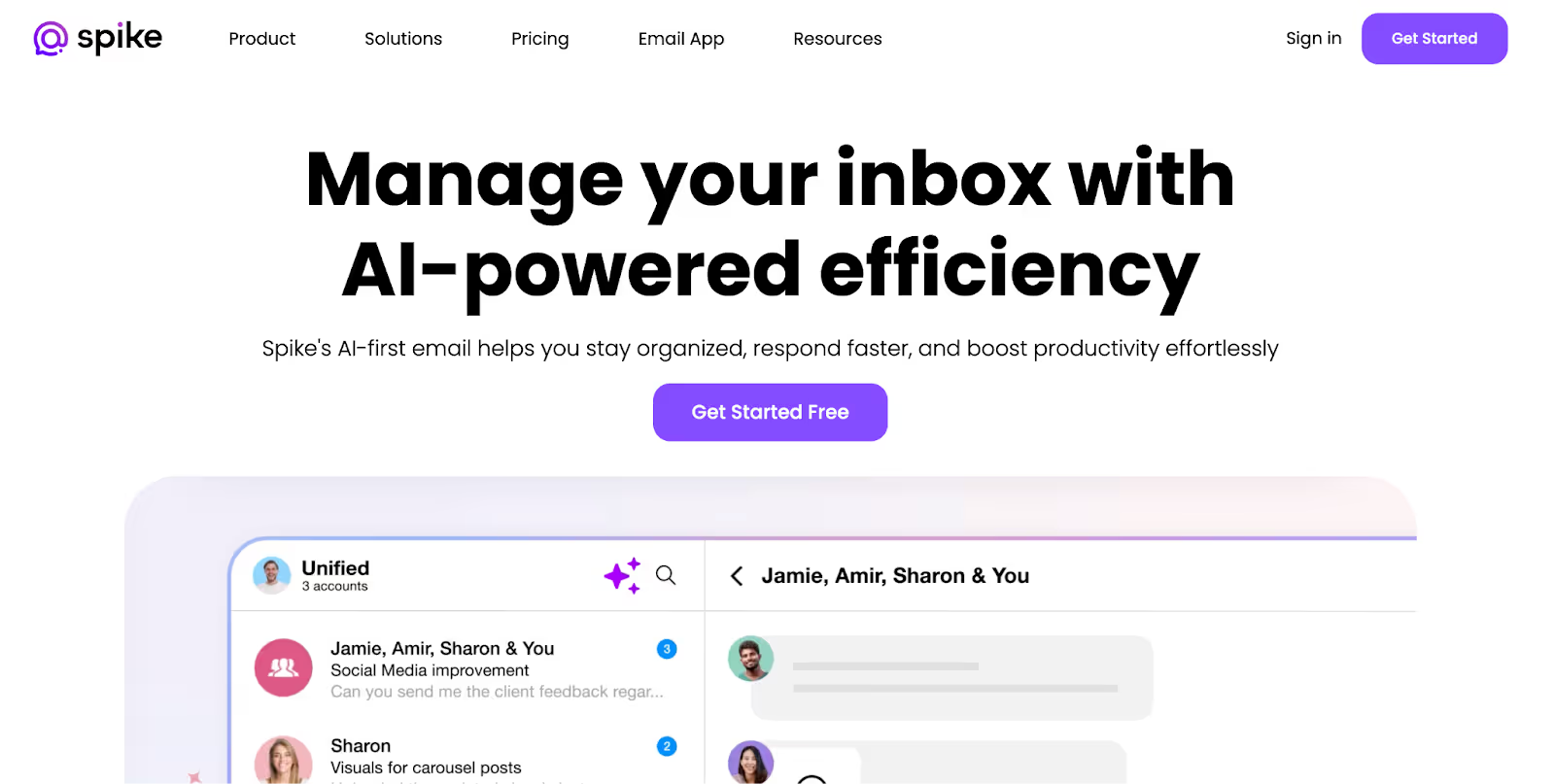
Spike reimagines email as a chat-like experience, blending emails, tasks, and team chats into one conversation-driven interface. Spike has a clean design, making it suitable for personal use, and ideal for freelancers or solopreneurs.
- Key Features:
- Conversational email: Chat-style interface
- Notes and tasks: Built-in productivity tools
- Multiple email accounts: Easily manage work and personal email
- Pros:
- Combines email, chat, and docs
- Mobile-first with desktop sync
- Built for solo workers and small teams
- Cons:
- Some collaboration features behind paywall
- May feel untraditional for email purists
- Pricing: Free for personal use; Paid plan starts at $5/user/month
- Platforms: Web, iOS, Android, macOS, Windows
- User Experience & Productivity Benefits: Spike’s chat-like design makes email feel conversational and fast, which helps freelancers stay responsive and engaged. Built-in notes, tasks, and calendars eliminate the need to jump between tools.
- What Makes It Unique: Spike blurs the line between email and instant messaging. By replacing threads with real-time conversations and integrating productivity tools into your inbox, it offers a radically different and efficient way to work solo.
- Best for: Freelancers who want more than just email
10. Front: Best for Teams
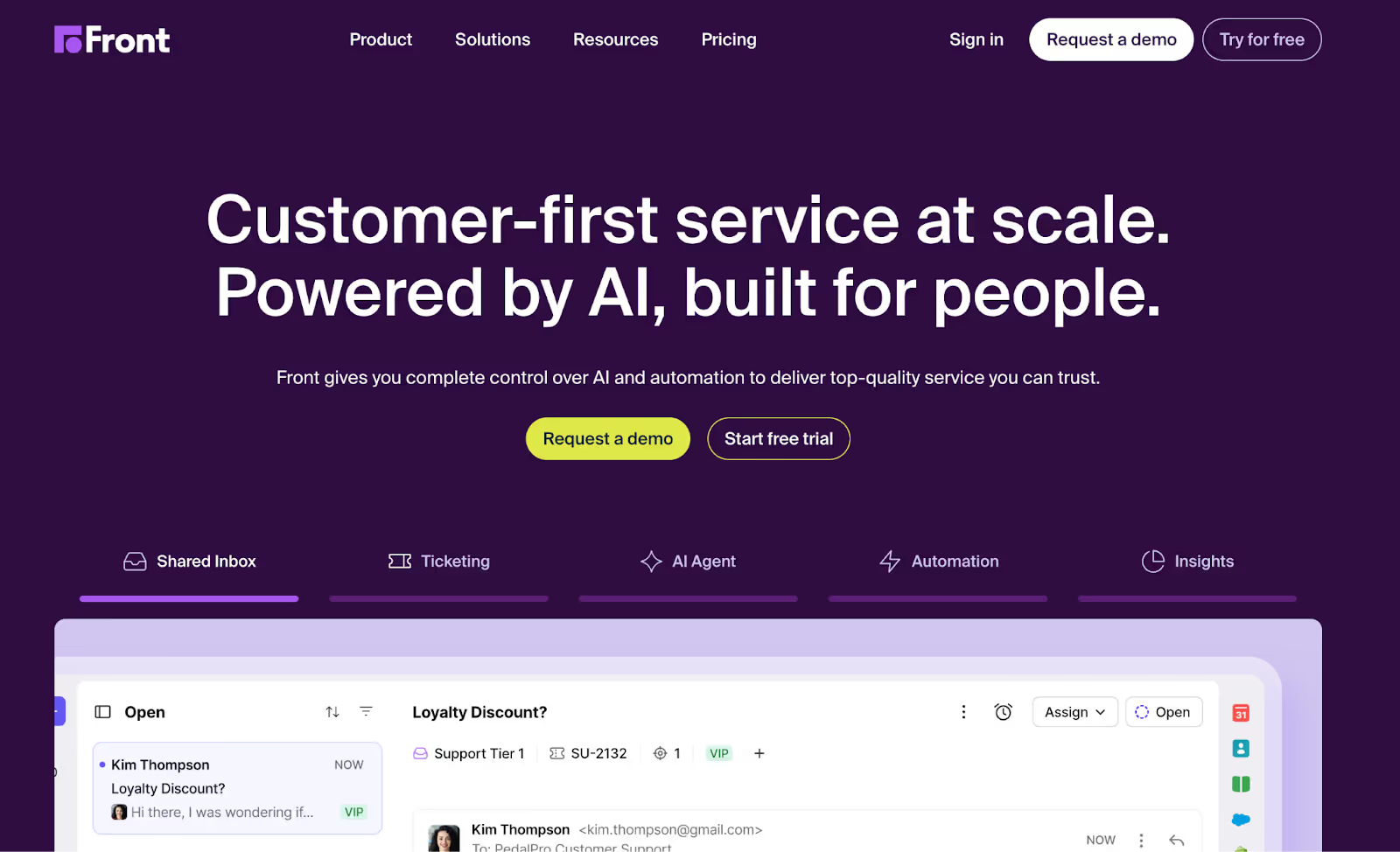
More than a standard email client, Front is a team inbox platform that brings visibility, collaboration, and analytics to your customer communication.
- Key Features:
- Shared inboxes: Collaborate on support or sales emails
- Internal comments and assignments: Tag teammates, route emails
- Analytics dashboard: Track team performance and SLAs
- Pros:
- Great for customer support and team workflows
- Enterprise-level control and integrations
- Built-in automation and analytics
- Cons:
- Expensive for small teams
- Learning curve for solo users
- Pricing: No free plan; Plans start at $19/user/month
- Platforms: Web, iOS, Android
- Best for: Support or sales teams with high email volumes
11. Mailspring: Best Lightweight Desktop Option

Mailspring is a minimalist, open-source desktop email app known for speed and essential multi-account features without unnecessary extras.
- Key Features:
- Unified inbox: Simple and fast UI
- Contact and read tracking: Optional features in Pro plan
- Keyboard shortcuts: Power-user friendly
- Pros:
- Lightweight and fast
- Open-source and extensible
- Focused on essentials
- Cons:
- No mobile version
- Lacks end-to-end encryption
- Pricing: Free plan available; Pro plan starts at $8/month
- Platforms: Windows, macOS, Linux
- User Experience & Productivity Benefits: Front offers powerful shared inbox features, making it easy for teams to collaborate on messages, tag teammates, and automate workflows. Its focus on visibility and accountability drives faster, clearer communication.
- What Makes It Unique: Front turns email into a collaborative workspace with features like internal comments, SLA tracking, and deep integrations with CRMs and helpdesk tools—something standard clients don’t offer.
- Best for: Minimalists and desktop-first users
12. Loop: Best for Shared Inboxes

Loop Email brings structure to team inboxes with shared email threads, internal chat, and a focus on collaboration.
- Key Features:
- Shared inbox view: Everyone sees what matters
- Internal chat: Discuss without forwarding threads
- Assignments: Route and track emails efficiently
- Pros:
- Easy collaboration without losing email context
- Combines chat and email well
- Designed for SMBs and client teams
- Cons:
- Less polished than major players
- Mobile app can feel clunky
- Pricing: No free plan; Paid plan starts at €15/month (billed annually)
- Platforms: Windows, macOS, iOS, Android
- User Experience & Productivity Benefits: Loop makes it easy for small teams to manage shared email threads without forwarding or losing context. Built-in chat and assignments streamline internal discussions and reduce response times.
- What Makes It Unique: Loop merges email with team chat and collaboration. Its shared inbox model, internal threads, and lightweight project tracking features give teams a more organized way to handle client communications.
- Best for: Teams managing shared email accounts
Why Canary Mail is the Best Email App for Multiple Accounts in 2025
Canary Mail isn’t just another email app—it’s designed from the ground up to simplify multi-account workflows while safeguarding your privacy and helping you stay productive.
- Unified Inbox: Canary’s unified inbox combines all your accounts into one intelligent view. No more switching tabs or accounts—just one streamlined interface where everything is accessible and organized.
- Multi-Account Support: Whether you’re managing two addresses or ten, the app handles them with ease. Each account retains its own settings, signatures, and notification settings.
- End-to-End Encryption: Canary uses strong encryption protocols, including PGP, to keep your communications secure. Perfect for professionals handling sensitive data or anyone concerned about privacy.
- Copilot AI: Introducing the future of email—compose, summarize, and reply with AI-powered precision and speed. Canary’s Copilot helps you respond faster and more effectively, whether you're swamped with outreach or buried in client queries.
- Built-in email security: Canary protects your data with encryption, two-factor authentication (2FA), and secure cloud syncing.
- Productivity Enhancing Features: With tools like Smart Filters, scheduled sends, and AI-powered triage, Canary is packed with features that help you enhance productivity at every touchpoint. Features like link tracking, automated workflows, and the ability to attach files also allow for detailed follow-up and better personal and professional communications. One of Gmail’s biggest weaknesses is unreliable tracking, which we covered in detail in our guide on how to tell if someone read your email on Gmail.
Whether you're a solopreneur, startup founder, or multitasking professional, this app offers the security, flexibility, and intelligence modern email demands.
Shared Inbox & AI: The Future of Multi-Account Email for Teams
Shared Inbox by Canary Mail (via shared-inbox.ai) takes multi-account email to the next level — blending AI automation, team collaboration, and inbox management. This is not just about handling multiple personal accounts — it’s about managing shared mailboxes, sales inboxes, and support queues, all with AI assistance.
Key features of Shared Inbox + AI:
- Auto-assignment & routing – AI routes incoming messages to the right team member.
- Smart replies & drafting – AI drafts replies based on past messages for faster, consistent responses.
- Workflows & automation – Auto-tagging, follow-ups, and duplicate thread merging reduce manual effort.
- Analytics & insights – Track response times, team productivity, and volume trends in real time.
- Multi-account & multi-organization support – Unified team inboxes from Gmail, Outlook, IMAP, and more.
- Simple setup – Teams can go live in minutes via shared-inbox.ai.
If your workflow requires not only managing multiple personal accounts but also team-level inbox management, this AI-powered solution extends Canary Mail’s vision into collaboration.
[cta-block:ctablock2,title="Try Shared Inbox by Canary Mail",button1="Explore Shared Inbox",button1link="https://shared-inbox.ai",button2="Download Canary Mail",button2link="https://canarymail.io/download"]
Tips for Efficiently Managing Multiple Email Accounts
Smart email habits can make or break your day, especially when juggling multiple email accounts.
Here’s how to streamline email productivity and reduce context switching:
1. Use smart filters and rules.
Automatically route newsletters, promotions, and low-priority messages to the right folders.
- Canary users benefit from Smart Filters that intelligently categorize and prioritize messages in real time—no manual setup needed.
2. Customize notifications by account.
Silence non-urgent inboxes and focus alerts on your primary account or work email to avoid burnout.
3. Use email templates and quick responses.
Save time with pre-made templates and reusable replies.
- Canary’s AI Copilot can also draft personalized responses for you—ideal for fast follow-ups and client communication.
4. Schedule emails strategically.
Instead of replying immediately, schedule emails to land at the right time. This helps maintain boundaries and ensures messages reach inboxes during peak engagement windows.
5. Batch inbox sessions to reduce context switching.
Don’t check your email all day. Set 2–3 focused blocks daily to triage and respond efficiently.
- Use Focus View in Canary to surface your most important messages during those sessions and avoid distractions.
6. Leverage third-party integrations.
Select an email client that seamlessly connects with tools such as calendars, CRMs, or task managers.
- Apps like Canary Mail and Mailbird offer seamless third-party integrations to enhance productivity without app switching. This is especially useful if you’re managing a mix of inboxes, like a personal Gmail and a work Outlook account, in one dashboard.
7. Choose a user-friendly interface.
A clean, intuitive dashboard makes it easier to manage all your accounts in one place, especially if you're switching from a cluttered Gmail alternative. With some apps, you can configure everything in just a few clicks during the initial setup.
8. Optimize inbox organization.
Use folders, labels, and pinned messages to maintain clarity across accounts. Features like Focus View help prioritize what matters most.
Final Verdict: What’s the Best Email App for Managing Multiple Accounts?
At the end of the day, the best email client is the one that fits your workflow, security needs, and preferred platforms. Whether you need smarter triage, stronger encryption, or a simpler way to manage multiple email accounts, the right email app makes all the difference.
If you want an email app that’s secure, fast, intelligent, and easy to use across devices, Canary Mail is the standout choice. It blends AI, encryption, and a unified inbox into a sleek experience that works the way you do.
With the right email client, managing all your email accounts can finally feel effortless.
Ready to simplify your inbox? Download Canary Mail and experience the future of email.
FAQs: Frequently Asked Questions About Multi-Account Email Apps
Do all these apps support a unified inbox for multiple accounts?
Most leading email apps support a unified inbox, but implementations vary. Confirm that you can view all accounts together, quickly filter to one, and search across all inboxes. See our roundup to compare better Mac email apps.
How can I keep work and personal accounts separate while using one app?
Use per-account profiles and rules: different signatures and reply-to, per-account notifications, and separate archive/sent folders. You can also create reusable templates for common replies, or switch from Apple Mail if you need more control.
What’s the safest way to add multiple accounts?
Prefer OAuth sign-in for Gmail, Microsoft 365, and iCloud. For IMAP/SMTP, use SSL/TLS, strong passwords, and app-specific passwords with 2FA. If security is a priority on iPhone, review our guide to secure setups on iOS (PGP).
Can I set different signatures, rules, and folders per account?
Yes in most multi-account clients: per-account signatures and auto-BCC, server- vs app-level rules, and custom default folders. If you’ve outgrown the basics, see Mac app alternatives with better rules.
How do I manage notifications for several inboxes without noise?
Enable notifications only for priority accounts, use VIP/sender filters, and set Do Not Disturb windows. To evaluate options, compare notification controls across apps.
Do these apps support send-delay or undo-send?
Many do. Set a 10–30s send delay to catch mistakes and use scheduled send for time zones. Learn more about the limits and workflows in how undo-send really works on iPhone.
How do I migrate from Apple Mail to a multi-account app?
Connect the same accounts via OAuth/IMAP in the new app and let it sync. If you need local history, export from Apple Mail as .mbox and import into the new client. For picks to switch to, check best alternatives to Apple Mail.
What about privacy—can these apps block tracking pixels?
Many clients can block remote images or tracking pixels. For reliable measurement, focus on link-click tracking and reply prompts. See why open tracking is inconsistent in our Mac read-receipts guide and how to track engagement without opens.
[cta-block:ctablock1,title="One inbox for all accounts. Get started today",button="Install free",buttonlink="https://canarymail.io/downloads"]